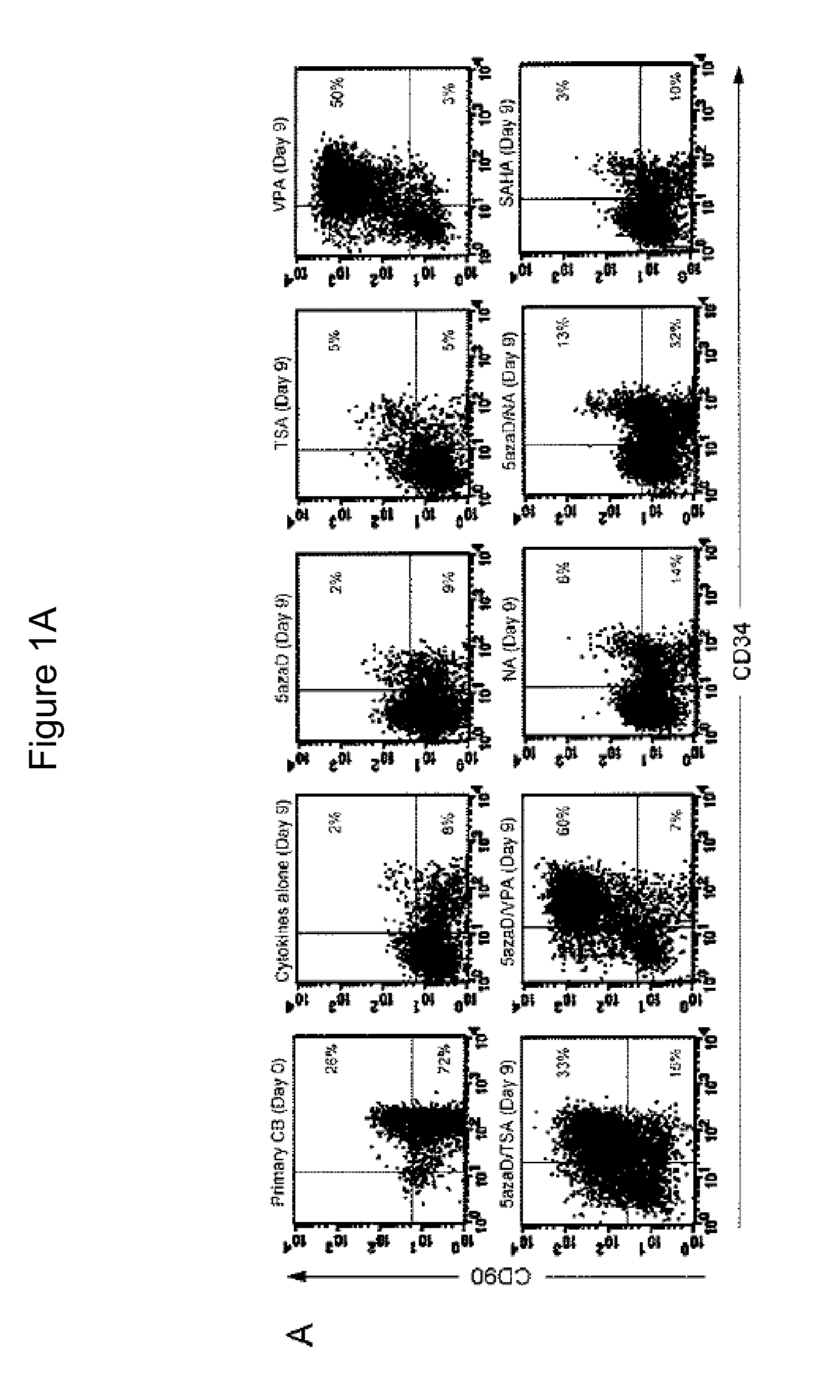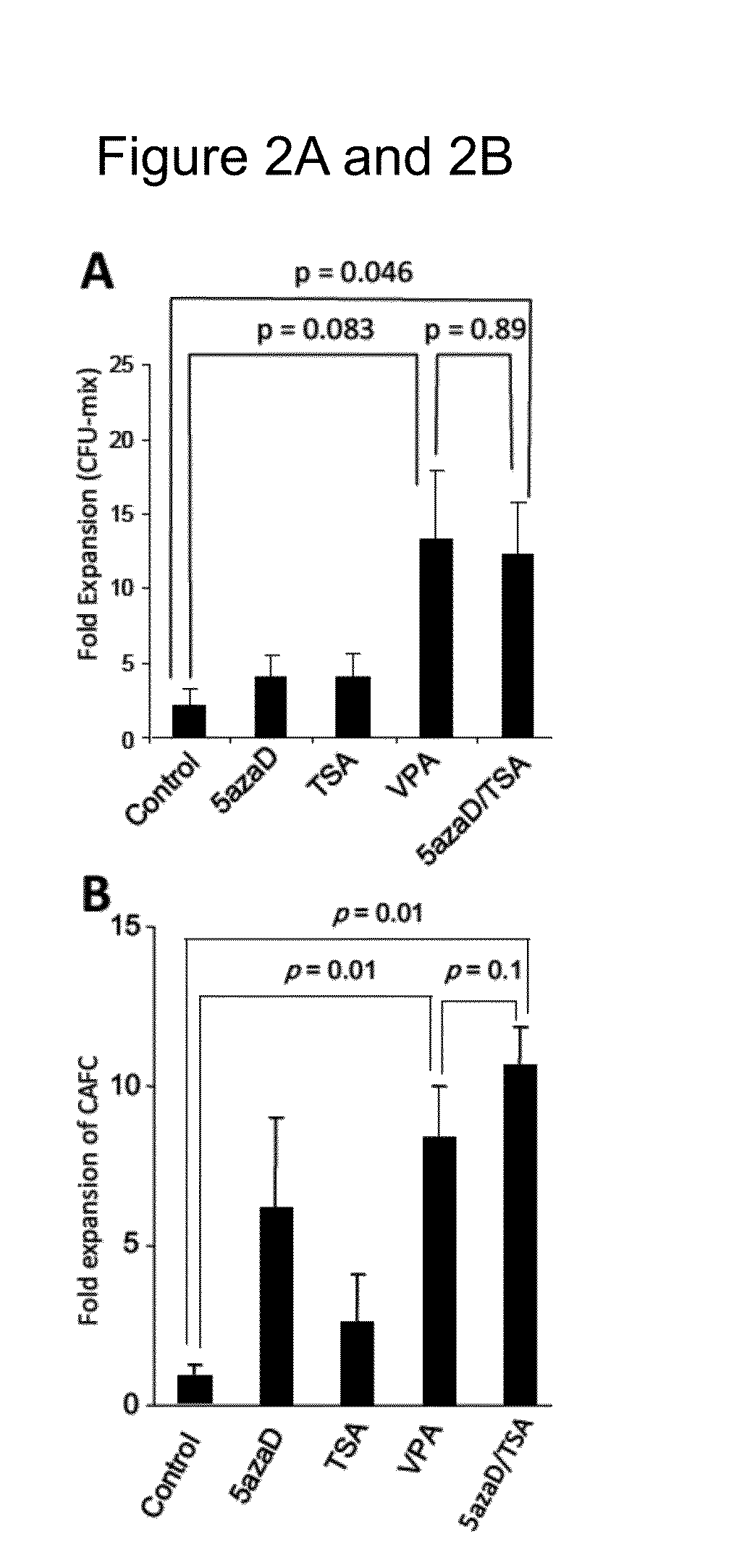Methods of Ex Vivo Expansion of Blood Progenitor Cells, and Generation of Composite Grafts
a technology of hematopoietic stem cells and composite grafts, which is applied in the field of hematopoietic progenitor cells and hematopoietic stem cells, can solve the problems of limited widespread use of allogeneic hsc transplantation, reduced treatment effectiveness with respect to long-term survival, and inability to obtain tissue-matched donors, etc., to achieve sustained blood cell production, improve patient survival, and prevent infection
- Summary
- Abstract
- Description
- Claims
- Application Information
AI Technical Summary
Benefits of technology
Problems solved by technology
Method used
Image
Examples
example 1
Valproic Acid Results in Expansion of Primitive CD34+CD90+ Cells
[0110]In order to compare the effects of various chromatin modifying agents (CMAs) on the degree of expansion of cord blood-derived, primitive subpopulation of CD34+ cells, valproic acid (VPA), trichostatin A (TSA), nicotinic acid (NA), suberoylanilide hydroxamic acid (SAHA) or 5-aza-2′-deoxycytidine (5azaD) as single agents or in combination was tested in vitro. The results of fluorescence-activated cell sorting experiments performed on cord blood-derived CD34+ / CD90+ cells treated with CMA agents is shown in FIG. 1A. Briefly, the cells were cultured for 9 days and 2% of cord blood cells that were exposed to cytokines (SCF, Flt3-ligand, TPO and IL-3) alone were found to co-express CD34+ and CD90+, while 2% (5azaD), 5% (TSA), 6% (NA), 13% (the combination of 5azaD and NA) and 3% (SAHA) of the cells in the cultures receiving a combination of cytokines and chromatin modifying agents co-expressed CD34+ and CD90+.
[0111]Speci...
example 2
Functional Potency of CMA Expanded Grafts-VPA Results in Maintenance while 5azaD / TSA Expands Transplantable HSC
[0112]Because 5azaD / TSA used in combination and VPA alone displayed the highest expansion of the absolute number of primitive CD34+CD90+ cells following culture, subsequent experiments used VPA or 5azaD / TSA in the culture media instead of cytokines alone. In order to determine the a correlation between expansion of CD34+CD90+ cells and their functional potential as pluripotent hematopoietic stem cells, in vitro functional assays were performed, including assessment of colony-forming cells (CFC), a short-term assay, and cobblestone-area forming cells (CAFC), a long-term assay. It had been previously shown that an increase in CD34+CD90+ cells following 5azaD / TSA treatment was accompanied by retention of the ability of these cells to produce CFC and CAFC (Araki et al., 2006, Exp Hematol. 34: 140-49; Araki et al., 2007, Blood 109: 3570-78; Araki et al., 2009, Exp Hematol. 37: 1...
example 3
Determination of Severe Combined Immunodeficiency (SCID)-Repopulating Cell (SRC) Frequency by Limiting Dilution Analyses
[0115]The frequency of SCID-repopulating cells (SRCs) present in VPA-expanded, CD34+CD90+ cord blood-derived stem cells was quantitated in comparison to unmanipulated primary cord blood cells by in vivo xeno-transplant studies using limiting dilution analyses as described previously (Conneally et al., 1997, Proc. Natl. Acad. Sci. 94: 9836-41; Bhatia et al., 1997, J Exp Med. 186: 619-24; Wang et al., 1997, Blood 89: 3919-24; Chute et al., 2005, Blood 105: 576-83). The frequency of SRC was 1 in 22,000 (95% Confidence Interval: 1 / 11,722-1 / 41,293) in primary CD34+CD90+ cells, and 1 in 21,720 (95% Confidence Interval: 1 / 11,160-1 / 42,269) in the VPA expanded cultures (Table 5 and FIG. 2E). It was previously demonstrated that cultures containing cytokines alone displayed an SRC frequency of 1 in 123,315, while 5azaD / TSA expanded cultures had an SRC frequency of 1 in 3,147,...
PUM
| Property | Measurement | Unit |
|---|---|---|
| concentration | aaaaa | aaaaa |
| density | aaaaa | aaaaa |
| concentration | aaaaa | aaaaa |
Abstract
Description
Claims
Application Information
 Login to View More
Login to View More - R&D
- Intellectual Property
- Life Sciences
- Materials
- Tech Scout
- Unparalleled Data Quality
- Higher Quality Content
- 60% Fewer Hallucinations
Browse by: Latest US Patents, China's latest patents, Technical Efficacy Thesaurus, Application Domain, Technology Topic, Popular Technical Reports.
© 2025 PatSnap. All rights reserved.Legal|Privacy policy|Modern Slavery Act Transparency Statement|Sitemap|About US| Contact US: help@patsnap.com



